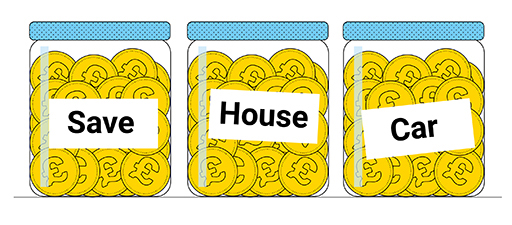5 Reorganising and reprioritising your spending
One step you can take to improve your finances by addressing your regular spending and seeing if there are potential changes to make.
Try the challenge in this next activity.
Activity 3: The £500 challenge
£500 goes some way to building up that rainy-day fund we looked at in the previous section. And if you manage to put away an extra £500 a year you’ll find yourself with a helpful lump sum in a few years’ time.
Or you can put it into your pension. An annual investment of £500 will grow close to an additional £25,000 after (for example) 25 years, assuming a constant rate of return on investments in the fund of 5% per annum. This ignores any tax relief you would get on these contributions or any matching contributions from an employer.
So your challenge is how would you go about saving £500 a year from your current spending?
First of all, we’d suggest making sure you’re getting the best deal possible on everything from your gas and electricity bills to your credit card debts. Make a note of all the money you have to pay out every month and use price comparison sites to look for better deals.
You might want to look at the tips for cutting energy costs provided by the Energy Saving Trust [Tip: hold Ctrl and click a link to open it in a new tab. (Hide tip)] .
Then take a look at your day-to-day spending. Here are some suggestions
- If you eat lunch away from home, make your own meal. A sandwich from a leading high street chain costs around £4 so you could save £20 over the course of a week. Even allowing for the cost of your home-made lunches the result is likely to mean savings in excess of £500 a year.
- If you travel to work by car is it possible to share lifts with a colleague? Even if your workplace is quite near, two fewer round trips each week could save you at least £5 a week or £250 a year.
- Cancel any subscriptions you don’t use very often – perhaps you have online streaming services or gym membership that you’re not getting value from.
- Use more than one supermarket to do your weekly shop. This way you’ll increase the scope to benefit from their special offers. And shop late in the day too as that’s when many items are marked down in price (commonly identified by a yellow sticker).
- How about selling items you no longer need to raise money? There are various online sites for selling second-hand items including clothing. You may be surprised to find how much people will pay for things you have no longer any use for.
Go through all your daily and weekly out-of-pocket expenses. Ask yourself: do I need it and, if so, can I get it more cheaply?
And of course, you don’t have to stop at saving £500 a year. If you’re lucky enough to be able to make bigger savings, then go for it!
If you found it easy to meet the £500 challenge why not raise the bar higher.to £1000 or perhaps even higher? Every penny counts, especially at the moment.

